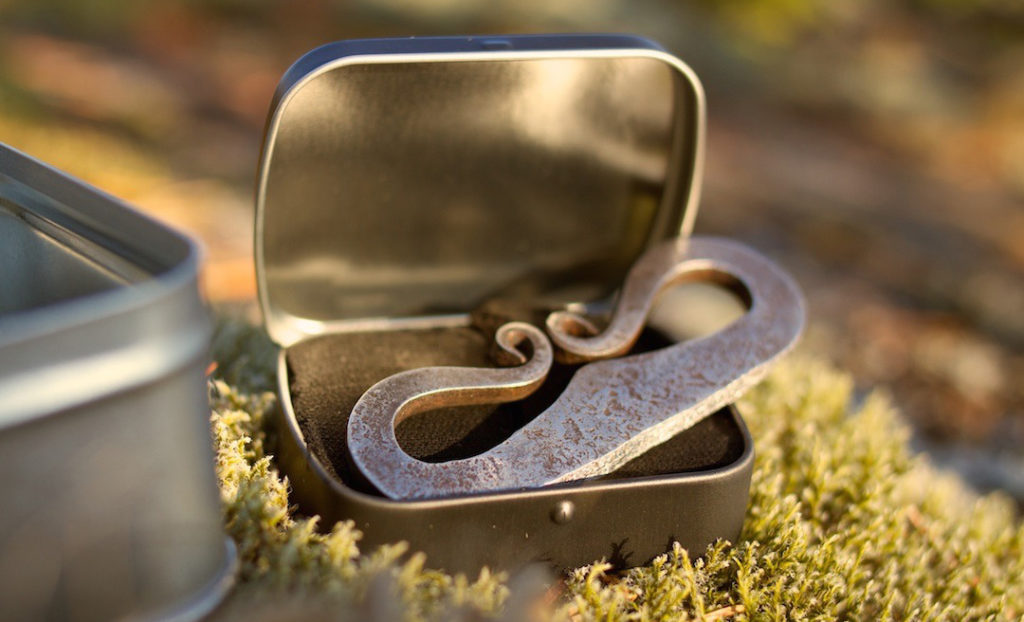
Starting a fire with flint and steel (the steel is also known as a “firesteel”) brings to mind the image of self-sufficient mountain men in the wilderness.
A rite of passage that ties you to wilderness travelers through the millennia, the ability to use flint and steal is one of the basic survival skills everyone should master.
But how does flint and steel work? More specifically, what causes the sparks when you strike a piece of flint with steel? The answer may surprise you!
The following information will help you understand what it takes to make fire using flint and steel or flint and FireSteel. It will change the way you look at flint and steel as a fire making tool and perhaps even make you a better flint and steel fire maker.
I believe that if you know the fundamental reasons why survival gear and survival techniques work then you are in a far better position to use them to best advantage.
The Secret of Flint and Steel for Making Fires
Outwardly the answer seems obvious; striking flint with steel produces hot sparks. However, dig a little deeper and you will find there is a lot more to it.
It all revolves around a little known fact about iron and some other metals that revolutionized the way people started fires thousands of years ago; pyrophorics.
Pyrophorics are substances that spontaneously ignite below room temperature, which is about 70°F (21°C). By spontaneous we mean these substances will simply catch on fire of their own accord without you having to do anything such as light it with a flame. This is also known as autoignition.
What many people do not realize is that iron is a pyrophoric material; in the presence of oxygen, iron catches on fire automatically! It just starts burning.
“But how can this be?” you may ask. “I can hold a chunk of iron in my hand and it does not burn me”. The answer lays in the fact that the portion of the iron object in contact with the air and your skin is not pure iron. Rather it has developed a thin coating of iron oxide, or rust, immediately upon contact with the oxygen in the air. This serves to seal off the iron inside from exposure to the air and reduces the rate of further rusting.
Cotton Ball Vaseline Fire Starters, How to Make and Carry Them
Rusting Produces Heat
Iron, whether man-made objects or naturally occurring in rocks, will rust upon exposure to oxygen in the air. The act of rusting is actually an exothermic reaction called “oxidation”, which is a fancy way of saying when iron touches the oxygen in the air a reaction occurs; the iron rusts (turns into iron oxide) and gives off heat. In other words, it burns.
The simplified chemical reaction can be expressed as:
Fe2 + O2 = Fe2O3 + heat
Or in simple English:
Iron + Oxygen = Rust + Heat
Rusting (oxidizing) is the exact same thing as burning, but unlike a campfire usually you will hardly notice it. Because of the relatively size of a typical iron object, the heat it gives off as it rusts dissipates too quickly for the heat to accumulate and be of much use.
While holding an ordinary iron object you are unlikely to feel any heat as it rusts, since the heat is absorbed by its surroundings as fast as the oxidation process produces it. However if you can increase the rate of oxidation you can cause the iron to spontaneously give off a large amount of heat very quickly.
How do you increase the rate of oxidization of iron? One way is to give a fresh un-oxidized piece of iron more surface area in contact with the air. More oxygen touching more iron will cause more oxidation which will give off more heat in a given amount of time.
Increased oxidation can be accomplished by breaking off smaller particles of iron from a bigger piece. The smaller the iron particle is, the greater its surface area compared to its total size.
Now you know the secret to using flint and steel to start a fire.
Have you ever used a metal grinder or seen one in action on a piece of iron? Notice how thousands of glowing hot sparks fly off the wheel as it removes tiny bits of fresh iron off the chunk of iron being worked on. These tiny bits of iron are actually spontaneously catching on fire as they are exposed to the oxygen in the air.
If you can create a small enough particle of fresh iron, upon contact with oxygen in the air the iron particles increased surface area will oxidize faster than it can dissipate the heat formed during the reaction.
The result: the particle of iron spontaneously becomes so hot that it glows as it oxidizes – and can be used to catch tinder on fire.
In a nutshell the process of using a flint and steel to start a fire works like this:
- Find a piece of high carbon steel, which is about 98% iron and 2% carbon (a hard, relatively brittle steel).
- Find a piece of flint or other hard sharp object such as quartz.
- Strike a sharp edge of the flint a glancing blow with the high carbon steel. Doing this just right takes practice.
- Very tiny particles of fresh iron fly out from the steel.
- Upon contact with oxygen in the air, the surfaces of the iron particles spontaneously ignite and give off heat as they oxidize (rust).
- Because the surface area of the iron particles is so large compared to their volume, the particles quickly heat up and glow red hot. They become sparks.
- Catch the sparks in prepared tinder and use it to start a fire.
Best Flint and Steel
Iron by itself is relatively soft and tends to bend rather than chip under the stress of a hard blow on a piece of flint. To make iron harder for use in industry, it is made into what we call steel by adding some carbon. However by making it harder, the steel is also becomes more brittle.
The harder a piece of steel the smaller the pieces of iron broken from it will be when struck against a hard sharp object. As discussed earlier, smaller pieces of iron will spontaneously burn hotter due to their increased surface area.
Another way to get hotter sparks is to break off smaller pieces from the steel by striking it against a harder, sharper object. This is why you need to keep the edges of your flint very sharp for optimum creation of hot sparks when striking the steel.
In short, harder steel and sharper flints give better sparks.
Flint isn’t the only mineral that will cause sparks when steel is struck against it. Any hard stone with a sharp fracture can be utilized as long as it can break off very small pieces of steel.
Advantages of Flint and Steel
Flint and Steel has been used in starting fires for centuries. In the days before matches were invented, flint and steel offered the ability to start a fire without having to carry a hot coal wherever one traveled, and worrying about losing it or having it go cold.
Starting a fire using flint and steel takes a more expertise and preparation than simply striking a match. However many survival experts feel this disadvantage is overcome by the fact that a wet or damp flint and steel can still be used to start a fire, and that a flint and steel can start many thousands of fires without wearing out; both very important attributes when surviving in the wilderness.
Try carrying tens of thousands of matches in the wilderness or stockpiling thousands of matches in your disaster preparedness kit! Even if the shear weight and volume of your matches do not discourage you, you are also faced with the problem of keeping them viable from dampness or the ravages of time.
Flint and steel overcomes these problems and provides the survivor with means of starting a fire that is more reliable than matches – if he is skilled enough to use it.
Find NOW The 3 Most Powerful Remedies That We Lost to History
Modern Flint and Steels
Some FireSteels contain a mix of metals that more readily oxidize. Typically in rod form, this type of firesteel produces a massive shower of very hot sparks by simply scraping it with the flint, This makes fire starting easier than when using traditional FireSteel but the principle is virtually identical.
FireSteel.com offers very high quality firesteels that are highly regarded throughout the world.
By John M.
Self-sufficiency and Preparedness solutions recommended for you:
Food for Freedom (If I want my family to survive, I need my own food reserve)
The Lost Ways (The vital self-sufficiency lessons our great grand-fathers left us)
Liberty Generator (How to gain complete energy independence)


